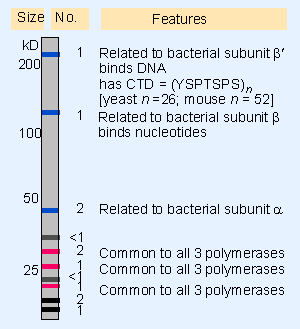2. Eukaryotic RNA polymerases consist of many subunits
20.2 Eukaryotic RNA polymerases consist of many subunits |
| Key terms defined in this section |
| Amanitin (more fully a-amanitin)is a bicyclic octapeptide derived from the poisonous mushroom Amanita phalloides; it inhibits transcription by certain eukaryotic RNA polymerases, especially RNA polymerase II. |
The three eukaryotic RNA polymerases have different locations in the nucleus, corresponding with their responsibilities (for review see 71).
The most prominent activity is the enzyme RNA polymerase I, which resides in the nucleolus and is responsible for transcribing the genes coding for rRNA. It accounts for most cellular RNA synthesis.
The other major enzyme is RNA polymerase II, located in the nucleoplasm (the part of the nucleus excluding the nucleolus). It represents most of the remaining cellular activity and is responsible for synthesizing heterogeneous nuclear RNA (hnRNA), the precursor for mRNA.
RNA polymerase III is a minor enzyme activity. This nucleoplasmic enzyme synthesizes tRNAs and other small RNAs.
A major distinction between the eukaryotic enzymes is drawn from their response to the bicyclic octapeptide α-amanitin. In cells from origins as divergent as animals, plants, and insects, the activity of RNA polymerase II is rapidly inhibited by low concentrations of α-amanitin. RNA polymerase I is not inhibited. The response of RNA polymerase III to α-amanitin has not been so well conserved; in animal cells it is inhibited by high levels, but in yeast and insects it is not inhibited.
 |
Figure 20.2 Eukaryotic RNA polymerase II has >10 subunits. |
All eukaryotic RNA polymerases are large proteins, appearing as aggregates of >500 kD. They typically have 8 V14 subunits. The purified enzyme can undertake template-dependent transcription of RNA, but is not able to initiate selectively at promoters. The general constitution of a eukaryotic RNA polymerase II enzyme as typified in S. cerevisiae is illustrated in Figure 20.2. The three largest subunits have homology to subunits of bacterial RNA polymerase; the two largest probably carry the catalytic site. Three of the remaining subunits are common to all the RNA polymerases, that is, they are also components of RNA polymerases I and III (for review see 222).
The largest subunit in RNA polymerase II has a carboxy-terminal domain (CTD), which consists of multiple repeats of a consensus sequence of 7 amino acids. The sequence is unique to RNA polymerase II. There are ~26 repeats in yeast and ~50 in mammals. The number of repeats is important, because deletions that remove (typically) more than half of the repeats are lethal (in yeast). The CTD can be highly phosphorylated on serine or threonine residues; this is involved in the initiation reaction (see later).
The RNA polymerase activities of mitochondria and chloroplasts are smaller, and resemble bacterial RNA polymerase rather than any of the nuclear enzymes. Of course, the organelle genomes are much smaller, the resident polymerase needs to transcribe relatively few genes, and the control of transcription is likely to be very much simpler (if existing at all). So these enzymes are analogous to the phage enzymes that have a single fixed purpose and do not need the ability to respond to a more complex environment.
| Reviews | |
| 71: | Doi, R. H. and Wang, L.-F. (1986). Multiple prokaryotic RNA polymerase sigma factors. Microbiol. Rev. 50, 227-243. |
| 222: | Young, R. A. (1991). RNA polymerase II. Ann. Rev. Biochem 60, 689-715. |
- Distributed Data Warehouse for Geo-spatial Services
- Data Mining for Business Process Reengineering
- Healthcare Information: From Administrative to Practice Databases
- A Hybrid Clustering Technique to Improve Patient Data Quality
- Relevance and Micro-Relevance for the Professional as Determinants of IT-Diffusion and IT-Use in Healthcare